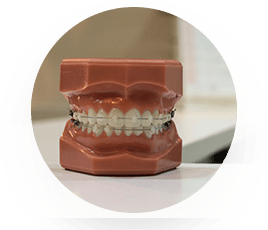Is it time for you to get the straight and picture-perfect smile you've been wanting? Whether you're looking for orthodontic treatment for yourself or a family member, there are more options than ever.
Gone are the days of bulky metal braces and sharp wires being your only option. With advancements in orthodontic care, you have the ability to craft your smile journey the way that you want it.
The most popular options are modern metal braces and Invisalign. Which is right for you? There are a few factors that you should consider.
Between the braces vs. Invisalign cost in Canada, the aesthetic factor, the condition that you're treating, and so much more, we want to cover everything that you need to know so you can make an educated decision about your smile.
Keep reading to learn about the primary differences between metal braces and Invisalign when it comes to patient preferences.
Get the Coverage You Want at the Best Rates
Looking for a Health and Dental plan that includes orthodontics?
Find one nowAesthetic Preferences
The primary difference between Invisalign and metal braces is obvious: the aesthetic factor. Adults who are seeking braces tend to put a lot of importance on this. They may be preparing for big events with a lot of photos, worried about public opinion, or worried about employability.
Regardless of the validity of these worries, let's talk about why someone may choose one option over the other.
Metal Braces
Metal braces are noticeable. There's no doubt about it. While they're less bulky than the braces of the past, they're obvious in a mouth whether it's opened or closed. They add some bulk to closed smiles and major shine to open ones.
That said, this isn't always a problem. Braces have become fashionable in some circles, and while fake braces aren't safe, real ones let you in on the trend.
Modern braces come in multiple colours and you can add rubber bands to change it up. There are also gold braces available at many orthodontic offices, so someone who wears a lot of gold may be interested in this functional accessory to match.
If you care about people knowing that you have braces, these aren't a great option. If you're ready to rock the metal mouth, though, consider them.
Invisalign
The appeal of clear aligners is obvious: they're almost invisible.
We'll explain a little deeper. People can (and likely will) notice your Invisalign close up. The aligners add a small amount of bulk to your smile, and they cause a bit of a lisp. They also add some extra shine, but who doesn't love shiny teeth?
That said, they're invisible in photos and they're far less noticeable than metal braces in all situations.
As far as adult braces go, clear aligners are more popular for aesthetics alone. Children and young teens aren't as concerned about the aesthetic factor.
Costs
What about the cost? Money is definitely a factor when it comes to orthodontic treatment, and it's no secret that it's expensive.
It's a worthwhile investment for a beautiful smile that will last a lifetime, though.
You'll be happy to know that we have health and dental insurance options that offset the prices of both metal braces and clear aligners so you don't have to stress as much about the cost.
But what's the difference?
How Much Do Braces Cost in Canada?
Metal braces have long been the most affordable option for professional orthodontic treatment. They're the default.
The price of braces will vary depending on the orthodontist, the kind of treatment that's needed, and even the city in which you're receiving treatment. The average cost is around $5,000, but it can range from $2,500 to $10,000 depending on the situation.
This is a hefty chunk of money, but it's still often the most affordable choice at many dental practices.
How Much Does Invisalign Cost in Canada?
There was a time when Invisalign was significantly more expensive than metal braces. Currently, though, this is no longer the case.
Invisalign is comparable in cost, and for some situations, may be more affordable than traditional orthodontic treatment. Some Invisalign providers offer a fast-track or lite system for mild cases.
The average prices are the same, but aligners don't often cost more than $8,000 aside from serious outliers.
Different Cost Factors
Treatment Details
- Age of patient
- Experience of the provider/orthodontist
Treatment Duration
- Orthodontist’s time for labour
Range of Issues
The more severe issues requiring correction the higher the cost
- Overbite
- Alignment issues
- Underbite
- crowding/spacing
Overall Responsibility Required
Many people don't consider responsibility when it comes to choosing orthodontic treatment options. This is a big monetary and time commitment, so you need to be ready for the appropriate care.
Let's talk about what kind of responsibility levels you'll need for each option.
Metal Braces
For the most part, metal braces are a "set it and forget it" option for orthodontic work. While you will need to go to the dentist or orthodontist for maintenance, and you'll have to be careful about your foods (more on that later), overall they're difficult to mess up.
It's possible to snap a wire, but this isn't a huge issue as long as you're able to get to your orthodontist.
This is one of the reasons that metal braces are so popular for children and younger teenagers. There's no way to lose them or mess them up.
Invisalign
Believe it or not, Invisalign requires more attention and responsibility than metal braces. While many people think that it's easier because the aligners pop in and out, this is actually one of the problems.
You need to remove braces during meals. For those who don't work at home or those who go to school, this makes lunchtime difficult. Aligners end up on a napkin most of the time. It's easy to throw away aligners by accident.
It's also essential to brush your teeth between eating your meal and putting your aligners back in. It's easy to get lazy with this. Neglecting to do so, though, traps sugar and food in the aligners which can do major damage to your teeth.
It's also important to remember to wear aligners for as many hours as possible. Orthodontists recommend that you wear them for 22 hours per day, or as close to that as you're able based on your meals.
Most adults have no problem with the responsibility required for Invisalign, but children and teenagers may want to stray away.
Orthodontist Visits
A huge and often-overlooked difference between Invisalign and standard metal braces is the amount of time you'll be spending with your orthodontist. For people with busy schedules, this is a problem.
Which works best for you?
Metal Braces
When you get metal braces, you'll visit your orthodontist often. You'll see them every 3 to 8 weeks depending on the severity of your condition, your age group, and how compliant you are with care.
The orthodontist takes this time to tighten and readjust your braces and make any necessary alterations to your treatment plan.
Invisalign
There are a few variables involved with Invisalign orthodontist visits. The first is the opinion of your orthodontist.
Technically speaking, you need to visit the orthodontist 2 times total when you get Invisalign. You visit for the initial checkup and scan and then you visit again to receive your aligners and make sure that you have a good fit.
Most orthodontists request that you see them more often (and some won't give you the full set of aligners at first for this reason). Some orthodontists are comfortable with you going months within visits paired with virtual check-ins, while others want to see you as often as they would with traditional braces.
For people who travel, or live a long distance from their orthodontist after moving, talk to your provider about the frequency of visits.
Want your Orthodontist Visits Covered?
Click here to find out more!
View articleBanned (and Allowed) Foods and Drinks
Everyone knows that orthodontic treatment will limit the foods and drinks that you're able to consume in some way. If one of your favorite foods will be taken away by one of these options, it's best to prepare ahead of time (or choose the other option).
Metal Braces
When you get metal braces, there are some foods that you'll have to avoid completely. Anything that's too hard should no longer be a part of your diet, as well as anything chewy (caramel and chewing gum lovers despair).
Popular snacks like popcorn and nuts are also inadvisable with braces, as well as a plethora of other tasty foods.
Even foods that are allowed should be chopped up into smaller pieces than usual to avoid any potential breaks, snags, or stuck food in braces.
Invisalign
Invisalign doesn't have any food restrictions per se, but there are still a few things that you need to keep in mind when you're planning out your meals and snacks.
You shouldn't eat or drink anything aside from water when your aligners are in place. Many people choose to drink tea, soft drinks, and alcohol through straws, but it's not advised. Eating is off the table, so snackers beware.
Drinks, while not harmful to the aligners, will discolor them. This will make your teeth appear to be discolored as well.
When you switch aligners every week to every other week, your teeth may feel loose and sensitive for the first day. On these days you should consider avoiding hard, chewy, or cold foods for your own comfort.
Conditions Treated
So what kind of conditions are treated by each option? There's a difference between having minor spacing issues and serious misalignment, so how do you know which is going to be the most effective for you?
Each mouth is different, and it's always good to get opinions from orthodontists before making your decision, but here are a few basics.
Metal Braces
Metal braces, as the gold standard, are used for almost every orthodontic problem. Some conditions require extra pieces, like headgear, extra rubber bands, or spacers.
People with complex dental problems or severe bite issues will want to choose metal braces. They're also able to handle minor issues like overcrowding, spacing, outliers, and more.
In other words, there are very few things that braces won't fix.
Invisalign
Again, Invisalign has changed a lot over the past few years. As more advancements come along, they're able to handle a wider range of conditions.
Almost any condition that braces can treat, Invisalign can also treat. Crowding, spacing, and bite problems (so long as they aren't too severe) are okay for Invisalign.
If your orthodontist suspects that you have short roots, or that Invisalign isn't appropriate for your situation, it's okay to seek a second opinion, but consider that metal braces are the better option for some severe conditions.
Time for Treatment
There's no doubt that realigning your teeth takes time. After all, you're shifting things that are set in your jaw. Adults will take a longer time than children as their jaws and teeth are finished forming.
So what process takes longer?
Metal Braces
Metal braces will be quicker for some cases. Complex orthodontic problems, even if they're fixable with Invisalign, are easier to fix with braces. This means that the process won't take as long.
The wires and brackets make quick work of problematic bites and spacing. People with open bites, severe overbites, and severe spacing and crowding issues will have a faster track to straight teeth if they use metal braces.
Invisalign
Invisalign has a comparable time commitment to metal braces and is sometimes a faster process (though again, it depends).
If your condition is mild and you're able to get a Lite treatment, it can take a matter of months to get the smile that you're looking for. A more serious treatment can take several years, perhaps even longer than traditional metal braces.
For many people, extended wear time is no problem with Invisalign because it's a more comfortable experience and other people won't notice your aligners.
'Want To Learn More About Dental Insurance?
Click here to learn more about different kinds of Dental Insurance.
View articleInvisalign vs Braces: The Decision Is Yours
Both Invisalign and traditional metal braces are great options for your treatment. Both will get you a straight and beautiful smile, and they've both made significant advancements over the years so they can treat more conditions in a shorter period of time.
With the Invisalign cost in Canada being close to the cost of metal braces, the treatment time being comparable, and the end result being the same straight and shiny teeth, both are great options.
There's no one "right" answer, so take a look at the qualities of each and talk to your orthodontist about the right treatment plan for you.
If you're in need of orthodontic treatment, don't hesitate to take a look at some of our comprehensive dental plans. Don't pay full price for Invisalign or metal braces. Get a quote today!








